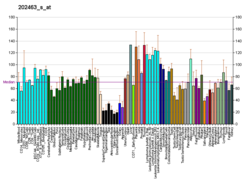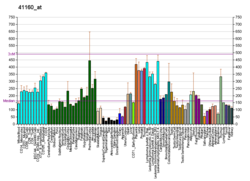Protein-coding gene in the species Homo sapiens
Methyl-CpG-binding domain protein 3 is a protein that in humans is encoded by the MBD3 gene .[ 5] [ 6] [ 7]
Function
DNA methylation is the major modification of eukaryotic genomes and plays an essential role in mammalian development. Human proteins MECP2 , MBD1 , MBD2 , MBD3, and MBD4 comprise a family of nuclear proteins related by the presence in each of a methyl-CpG binding domain (MBD). However, unlike the other family members, MBD3 is not capable of binding to methylated DNA but instead binds to hydroxymethylated DNA .[ 8] NuRD , a multisubunit complex containing nucleosome remodeling and histone deacetylase activities. MBD3 mediates the association of metastasis-associated protein 2 (MTA2) with the core histone deacetylase complex.[ 7]
MBD3 also contains the coiled‐coil domain common to all three MBD3 isoforms.[ 9]
Interactions
MBD3 has been shown to interact with:
References
^ a b c GRCh38: Ensembl release 89: ENSG00000071655 – Ensembl , May 2017^ a b c GRCm38: Ensembl release 89: ENSMUSG00000035478 – Ensembl , May 2017^ "Human PubMed Reference:" . National Center for Biotechnology Information, U.S. National Library of Medicine .^ "Mouse PubMed Reference:" . National Center for Biotechnology Information, U.S. National Library of Medicine .^ Hendrich B, Bird A (November 1998). "Identification and characterization of a family of mammalian methyl-CpG binding proteins" . Molecular and Cellular Biology . 18 (11): 6538– 47. doi :10.1128/mcb.18.11.6538 . PMC 109239 PMID 9774669 . ^ Hendrich B, Abbott C, McQueen H, Chambers D, Cross S, Bird A (September 1999). "Genomic structure and chromosomal mapping of the murine and human Mbd1, Mbd2, Mbd3, and Mbd4 genes". Mammalian Genome . 10 (9): 906– 12. doi :10.1007/s003359901112 . PMID 10441743 . S2CID 819148 . ^ a b "Entrez Gene: MBD3 methyl-CpG binding domain protein 3" .^ Yildirim O, Li R, Hung JH, Chen PB, Dong X, Ee LS, Weng Z, Rando OJ, Fazzio TG (December 2011). "Mbd3/NURD complex regulates expression of 5-hydroxymethylcytosine marked genes in embryonic stem cells" . Cell . 147 (7): 1498– 510. doi :10.1016/j.cell.2011.11.054 . PMC 3252821 PMID 22196727 . ^ Hirasaki M, Ueda A, Asaka MN, Uranishi K, Suzuki A, Kohda M, Mizuno Y, Okazaki Y, Nishimoto M, Sharif J, Koseki H, Okuda A (May 2018). "Identification of the Coiled-Coil Domain as an Essential Mbd3 Element for Preserving Lineage Commitment Potential of Embryonic Stem Cells" . Stem Cells . 36 (9): 1355– 1367. doi :10.1002/stem.2849 PMID 29761578 . ^ a b c Sakai H, Urano T, Ookata K, Kim MH, Hirai Y, Saito M, Nojima Y, Ishikawa F (December 2002). "MBD3 and HDAC1, two components of the NuRD complex, are localized at Aurora-A-positive centrosomes in M phase" . The Journal of Biological Chemistry . 277 (50): 48714– 23. doi :10.1074/jbc.M208461200 PMID 12354758 . ^ Brackertz M, Boeke J, Zhang R, Renkawitz R (October 2002). "Two highly related p66 proteins comprise a new family of potent transcriptional repressors interacting with MBD2 and MBD3" . The Journal of Biological Chemistry . 277 (43): 40958– 66. doi :10.1074/jbc.M207467200 PMID 12183469 . ^ Feng Q, Cao R, Xia L, Erdjument-Bromage H, Tempst P, Zhang Y (January 2002). "Identification and functional characterization of the p66/p68 components of the MeCP1 complex" . Molecular and Cellular Biology . 22 (2): 536– 46. doi :10.1128/MCB.22.2.536-546.2002 . PMC 139742 PMID 11756549 . ^ a b c Zhang Y, Ng HH, Erdjument-Bromage H, Tempst P, Bird A, Reinberg D (August 1999). "Analysis of the NuRD subunits reveals a histone deacetylase core complex and a connection with DNA methylation" . Genes & Development . 13 (15): 1924– 35. doi :10.1101/gad.13.15.1924 . PMC 316920 PMID 10444591 . ^ a b Saito M, Ishikawa F (September 2002). "The mCpG-binding domain of human MBD3 does not bind to mCpG but interacts with NuRD/Mi2 components HDAC1 and MTA2" . The Journal of Biological Chemistry . 277 (38): 35434– 9. doi :10.1074/jbc.M203455200 PMID 12124384 . ^ Jiang CL, Jin SG, Pfeifer GP (December 2004). "MBD3L1 is a transcriptional repressor that interacts with methyl-CpG-binding protein 2 (MBD2) and components of the NuRD complex" . The Journal of Biological Chemistry . 279 (50): 52456– 64. doi :10.1074/jbc.M409149200 PMID 15456747 .
Further reading
Shen L, Zhang Y (June 2013). "5-Hydroxymethylcytosine: generation, fate, and genomic distribution" . Current Opinion in Cell Biology . 25 (3): 289– 96. doi :10.1016/j.ceb.2013.02.017 . PMC 4060438 PMID 23498661 . Abbott WM, Mellor A, Edwards Y, Feizi T (April 1989). "Soluble bovine galactose-binding lectin. cDNA cloning reveals the complete amino acid sequence and an antigenic relationship with the major encephalitogenic domain of myelin basic protein" . The Biochemical Journal . 259 (1): 283– 90. doi :10.1042/bj2590283 . PMC 1138502 PMID 2470348 . Zhang Y, LeRoy G, Seelig HP, Lane WS, Reinberg D (October 1998). "The dermatomyositis-specific autoantigen Mi2 is a component of a complex containing histone deacetylase and nucleosome remodeling activities" . Cell . 95 (2): 279– 89. doi :10.1016/S0092-8674(00)81758-4 PMID 9790534 . S2CID 18786866 . Tong JK, Hassig CA, Schnitzler GR, Kingston RE, Schreiber SL (October 1998). "Chromatin deacetylation by an ATP-dependent nucleosome remodelling complex". Nature . 395 (6705): 917– 21. Bibcode :1998Natur.395..917T . doi :10.1038/27699 . PMID 9804427 . S2CID 4355885 . Zhang Y, Ng HH, Erdjument-Bromage H, Tempst P, Bird A, Reinberg D (August 1999). "Analysis of the NuRD subunits reveals a histone deacetylase core complex and a connection with DNA methylation" . Genes & Development . 13 (15): 1924– 35. doi :10.1101/gad.13.15.1924 . PMC 316920 PMID 10444591 . Wade PA, Gegonne A, Jones PL, Ballestar E, Aubry F, Wolffe AP (September 1999). "Mi-2 complex couples DNA methylation to chromatin remodelling and histone deacetylation". Nature Genetics . 23 (1): 62– 6. doi :10.1038/12664 . PMID 10471500 . S2CID 52868103 . Tatematsu KI, Yamazaki T, Ishikawa F (August 2000). "MBD2-MBD3 complex binds to hemi-methylated DNA and forms a complex containing DNMT1 at the replication foci in late S phase" . Genes to Cells . 5 (8): 677– 88. doi :10.1046/j.1365-2443.2000.00359.x PMID 10947852 . S2CID 25185979 . Humphrey GW, Wang Y, Russanova VR, Hirai T, Qin J, Nakatani Y, Howard BH (March 2001). "Stable histone deacetylase complexes distinguished by the presence of SANT domain proteins CoREST/kiaa0071 and Mta-L1" . The Journal of Biological Chemistry . 276 (9): 6817– 24. doi :10.1074/jbc.M007372200 PMID 11102443 . Shi Y, Downes M, Xie W, Kao HY, Ordentlich P, Tsai CC, Hon M, Evans RM (May 2001). "Sharp, an inducible cofactor that integrates nuclear receptor repression and activation" . Genes & Development . 15 (9): 1140– 51. doi :10.1101/gad.871201 . PMC 312688 PMID 11331609 . Feng Q, Cao R, Xia L, Erdjument-Bromage H, Tempst P, Zhang Y (January 2002). "Identification and functional characterization of the p66/p68 components of the MeCP1 complex" . Molecular and Cellular Biology . 22 (2): 536– 46. doi :10.1128/MCB.22.2.536-546.2002 . PMC 139742 PMID 11756549 . Schlegel J, Güneysu S, Mennel HD (2002). "Expression of the genes of methyl-binding domain proteins in human gliomas". Oncology Reports . 9 (2): 393– 5. doi :10.3892/or.9.2.393 . PMID 11836615 . Saito M, Ishikawa F (September 2002). "The mCpG-binding domain of human MBD3 does not bind to mCpG but interacts with NuRD/Mi2 components HDAC1 and MTA2" . The Journal of Biological Chemistry . 277 (38): 35434– 9. doi :10.1074/jbc.M203455200 PMID 12124384 . Brackertz M, Boeke J, Zhang R, Renkawitz R (October 2002). "Two highly related p66 proteins comprise a new family of potent transcriptional repressors interacting with MBD2 and MBD3" . The Journal of Biological Chemistry . 277 (43): 40958– 66. doi :10.1074/jbc.M207467200 PMID 12183469 . Sakai H, Urano T, Ookata K, Kim MH, Hirai Y, Saito M, Nojima Y, Ishikawa F (December 2002). "MBD3 and HDAC1, two components of the NuRD complex, are localized at Aurora-A-positive centrosomes in M phase" . The Journal of Biological Chemistry . 277 (50): 48714– 23. doi :10.1074/jbc.M208461200 PMID 12354758 . Fujita N, Jaye DL, Kajita M, Geigerman C, Moreno CS, Wade PA (April 2003). "MTA3, a Mi-2/NuRD complex subunit, regulates an invasive growth pathway in breast cancer" . Cell . 113 (2): 207– 19. doi :10.1016/S0092-8674(03)00234-4 PMID 12705869 . S2CID 5773916 . Fujita N, Jaye DL, Geigerman C, Akyildiz A, Mooney MR, Boss JM, Wade PA (October 2004). "MTA3 and the Mi-2/NuRD complex regulate cell fate during B lymphocyte differentiation" . Cell . 119 (1): 75– 86. doi :10.1016/j.cell.2004.09.014 PMID 15454082 . S2CID 17391732 .





